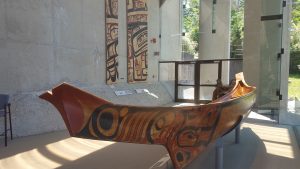The field trip really resonated with me as I am very interested in the historical artifacts, the people and the places that the indigenous people inhabit. As a geographer and anthropology major, I’m naturally focused on our local environment and the lessons that indigenous people can offer us. I’m also a mariner, or one who enjoys the ocean so the canoe was the most interesting item in the museum. It symbolizes the technological advances of the people as well as the extent of their land – since they were able to travel far and wide for trade and resources.
To me the extent to which the Haida people lived throughout the islands of the north coast is a phenomena unparalleled by any. These people can show us many things today in the symbiotic and harmony that they lived in. They were advanced in their understanding and connection to the land. Are we learning from them? After the residential schools it seems ironic that the teachings of coastal native people are now being modelled in our attitudes to our environment and our connection to the land. Explorers and settlers should have been listening during the early periods of contact.
This canoe was created by Bill Reid in 1985. The First Nations people of the Northwest coast are renowned for their elegantly engineered canoes. They ranged in length from three to twenty meters. They were essential for travel, transport, hunting and trade. Different coastal communities developed distinctive styles to suit their particular needs. Each canoe is made from a single cedar log, carved and steamed into shape.
